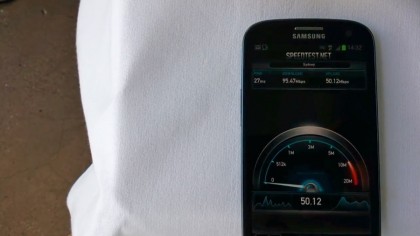Voda Fones Home: The launch of Australia's third LTE network
Vodafone is staging a comeback, launching LTE to its customers this week
"Everybody loves talking about headline speeds, but at the end of the day, really what customers are looking for is a more consistent experience day to day on the network, and with the amount of spectrum that we have, we're able to better offer that more consistent experience," Didovich told us.
There's also a convenient knock-on effect for the 3G and 3G+ networks as customers transition over to LTE and ease the load on the slower networks
According to Robert Glennon, the difference in load for 3G was evident within hours of switching on 4G for a limited number of current customers this week.
"It's good news for the 3G network because the more 3G customers you migrate over to 4G, that's more and more capacity freed up on the 3G network," Glennon explained.
"We've already seen some examples of customers on the 3G network complimenting us on the speed improvement they saw, just in the busy hour [of launch day] afternoon."
But for all the talk of contiguous spectrum, the advantage is only temporary. Come 2015, the spectrum made available from the digital dividend auction will come online for Telstra and Optus, and the rival telcos will be able to offer similar bandwidth advantages.
It's something Vodafone is aware of, but Didovich denied that Vodafone not taking part in the auction will put them at a disadvantage down the track.
Get daily insight, inspiration and deals in your inbox
Sign up for breaking news, reviews, opinion, top tech deals, and more.
"In the short term, or short to medium term, we will maintain an advantage in our spectrum holding, and that will translate to a better, more consistent customer experience as the network becomes loaded, and also from a headline speed perspective as well," Didovich explained.
"We've got some strategic plans about best utilisation of our spectrum holdings. We don't believe we'll be at any disadvantage in the future, which is the reason why we didn't participate [in the auction]," he added.
Ping: 39ms Download: 59..3Mbps Upload: 17.2Mbps
Like women in the proverb, a network builder's work is never done. One of the biggest challenges with creating a new network - and an LTE network in particular - is ensuring it works well with all kinds of devices.
"A network is sort of a living, breathing thing, and really, the reference to the customer is through the handset. And we know from our own experience how most devices perform on the other networks, and I can tell you we've set ourselves some pretty high standards in certification of these devices," Didovich told us.
The challenge arises from differing implementations across device manufacturers.
"The way in which Samsung might implement something versus Apple versus HTC can often mean that you have decisions to make in the way which you configure your network," he explained.
"And we know for a fact that other networks have suffered quite a bit because they've had to bias their network substantially to support a more popular device, and therefore compromise the experience of other users. But we think we've got pretty much the right mix now."
As part of ensuring the best performance across the board, Vodafone has expanded its certification processes for handsets.
"With LTE, there's some extra challenges as well around having devices moving between 3G and 4G coverage and some of the challenges that are well documented around battery life and various other things," Didovich said.

"Some of the tricks that some of the other guys have gone into in the earlier days were that the networks competed to supported a particular device, but other devices performed poorly.
"So what was happening in the earlier days of LTE was that people were actually switching LTE off on their devices. They were having extreme challenges with things like battery life and whatnot," he added.